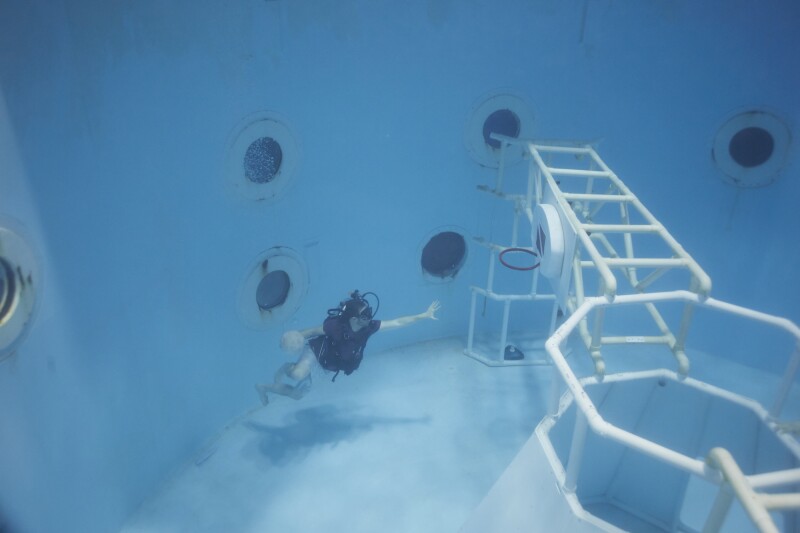There’s only one place in the solar system where you can wear a flight suit, experience weightlessness, and work on rockets, all without entering orbit: Space Camp. And, until recently, no grown-ups were allowed.
But this summer, NASA’s Space Camp will open its doors to adults, offering three-day, two-night camps to anyone over the age of 18 with $549 and an unrealized astronaut dream.
The program bears some similarities to the junior version: Campers reside in bunks at the Space Academy Habitats in Huntsville, Alabama, and eat at the crew galley with camp guides and staff. (There are quotes and recorded commentary from former astronauts in the camp’s various exhibits, but no astronauts are on hand in Huntsville.) Activities, however, are geared toward adults. For example, the camp trained the cast of MARS, the National Geographic series that explores a speculative tale of a human settlement on the Red Planet. Those same learning tools—from spacewalk simulators to science experiment kits—await the adult Space Camp voyager.

Moonwalking isn’t as easy as Neil Armstrong made it look.
Photo courtesy of National Geographic
I was one of the lucky few who got to participate in the launch of Adult Space Academy. On my first day, I walked past mock-ups of a massive Saturn V rocket and Space Shuttle Pathfinder to find our friendly trainer, Katie Kanable. “Don’t worry!” Kanable said as we wriggled into our flight suits. “In a few moments, I’ll answer the most important question right away because it gets asked, no matter the age group.”
As promised, she spent a couple of minutes explaining how the brilliant men and women of our space program go to the bathroom in orbit. With that item checked, our team jumped into action and split into flight crews and Mission Control teams for a simulated Space Shuttle mission.
Our goal? To perform a crew swap with the International Space Station (ISS). Some of us moved into a model of a Space Shuttle control cabin, while others changed into space suits in the model of the ISS to await the personnel exchange.

The author in his role as CAPCOM, the veteran astronaut on the ground.
Photo courtesy of National Geographic
I headed to Mission Control to serve as CAPCOM, the veteran astronaut on the ground who speaks directly to the Shuttle Commander. My workstation included two data-stuffed screens monitoring the condition of the shuttle and the mission, a binder of emergency procedures, and a headset to talk to the shuttle commander—everything a real CAPCOM would need to guide a crew swap. And, as in real-life situations, nothing went to plan. The simulation threw problems at the ship and Mission Control. As the ground crew figured how to solve each snag, I relayed the instructions up to the ship and the ISS. The team-building began as Houston and the Enterprise worked together, narrowly averting disaster to bring ship and astronauts home safely.
From there, the day-one exercises came as fast as meteors. We explored both the physicality and the mental acumen of astronauts. We moonwalked in harnesses attached to springs that simulate the moon’s gravity (one-sixth what it is on Earth). We strapped into spinning, tilting multi-axis chairs that offer a taste of weightlessness. To better understand the principles of thrust, we built simple rockets using DIY model kits and launched them into successful, if brief, flights above the Huntsville trees.
The second day opened with one of the more impressive Space Camp challenges: a scuba dive into a 30-foot-deep underwater training tank to get a feel for what it would be like to do repairs in an airless vacuum while weightless (a similar system to what NASA uses to train astronauts). After passing a basic dive training, we aquanauts descended to assemble a PVC tubing structure akin to a simple shelter. A repair of the Hubble it was not, but we got the general idea.

A training tank allows campers to experience what it would be like to work (or play basketball) while weightless.
Photo courtesy of National Geographic
Next came one of the most challenging team exercises. Our small groups were tasked with building a tiny simulacrum of the shields that protect returning spacecraft as they pass through Earth’s scorching upper atmosphere. Using a combination of foil, cork, spackle, and pasta (hey, NASA provides the materials), my team built a s’mores-size heat shield to protect a raw egg from a blow torch for three minutes. My squad’s egg lasted about 125 seconds before the flames braised its backside. Houston, we have an omelet.
The camp’s big finish on day two highlighted NASA’s major long-term goal: humanity’s first journey to Mars. (Day three solely includes graduation and departures.) I drew the plum assignment of Mission Commander, piloting a four-member crew aboard the Orion spacecraft. Scientists say such a mission will be a one-way trip when the time comes for those first interplanetary colonists, and the Space Camp’s staff insists each faux Mission Commander come up with those all-important first words on Mars.
After a successful landing at our new Martian home, I unsealed Orion’s hatch and strode onto the imaginary scarlet dust with: “Couldn’t you put out some snacks or something?”
Clearly, I’m no Neil Armstrong, but I still graduated. On my way back to Earth, post-camp, I thought about how every moment of the past three days served to outline the expertise, dedication, and genius necessary for NASA’s real achievements. Space Camp exists to inspire kids to become astronauts—and to remind adults of how much humans can achieve together.











